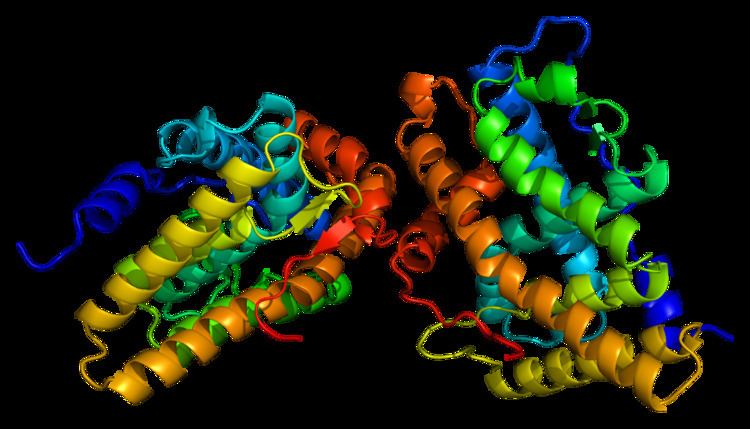Entrez 5241 | Ensembl ENSG00000082175 | |
 | ||
External IDs MGI: 97567 HomoloGene: 713 GeneCards: PGR | ||
The progesterone receptor (PR), also known as NR3C3 or nuclear receptor subfamily 3, group C, member 3, is a protein found inside cells. It is activated by the steroid hormone progesterone.
Contents
In humans, PR is encoded by a single PGR gene residing on chromosome 11q22, it has two main forms, PRA and PRB, that differ in their molecular weight. A third, lesser-known isoform, the PRC, also exists.
Function
Progesterone is necessary to induce the progesterone receptors. When no binding hormone is present the carboxyl terminal inhibits transcription. Binding to a hormone induces a structural change that removes the inhibitory action. Progesterone antagonists prevent the structural reconfiguration.
After progesterone binds to the receptor, restructuring with dimerization follows and the complex enters the nucleus and binds to DNA. There transcription takes place, resulting in formation of messenger RNA that is translated by ribosomes to produce specific proteins.
Structure
In common with other steroid receptors, the progesterone receptor has a N-terminal regulatory domain, a DNA binding domain, a hinge section, and a C-terminal ligand binding domain. A special transcription activation function (TAF), called TAF-3, is present in the progesterone receptor-B, in a B-upstream segment (BUS) at the amino acid terminal. This segment is not present in the receptor-A.
Isoforms
As demonstrated in progesterone receptor-deficient mice, the physiological effects of progesterone depend completely on the presence of the human progesterone receptor (hPR), a member of the steroid-receptor superfamily of nuclear receptors. The single-copy human (hPR) gene uses separate promoters and translational start sites to produce two isoforms, hPR-A and -B, which are identical except for an additional 165 amino acids present only in the N terminus of hPR-B. Although hPR-B shares many important structural domains with hPR-A, they are in fact two functionally distinct transcription factors, mediating their own response genes and physiological effects with little overlap. Selective ablation of PR-A in a mouse model, resulting in exclusive production of PR-B, unexpectedly revealed that PR-B contributes to, rather than inhibits, epithelial cell proliferation both in response to estrogen alone and in the presence of progesterone and estrogen. These results suggest that in the uterus, the PR-A isoform is necessary to oppose estrogen-induced proliferation as well as PR-B-dependent proliferation.
Functional polymorphisms
Six variable sites, including four polymorphisms and five common haplotypes have been identified in the human PR gene . One promoter region polymorphism, +331G/A, creates a unique transcription start site. Biochemical assays showed that the +331G/A polymorphism increases transcription of the PR gene, favoring production of hPR-B in an Ishikawa endometrial cancer cell line.
Several studies have now shown no association between progesterone receptor gene +331G/A polymorphisms and breast or endometrial cancers. However, these follow-up studies lacked the sample size and statistical power to make any definitive conclusions, due to the rarity of the +331A SNP. It is currently unknown which if any polymorphisms in this receptor are of significance to cancer.
Biological role
Knockout mice of the PR have been found to have severely impaired lobuloalveolar development of the mammary glands as well as delayed but otherwise normal mammary ductal development at puberty.
Antagonists
Progesterone receptor antagonists work as antiprogestins. The main example is mifepristone. Selective progesterone receptor modulators may also have more or less antagonist activity. Additional PR antagonists include: onapristone (ZK98299), lonaprisan (ZK230211, BAY86-5044), APR19, EC304, WAY-255348, ORG31710, asoprisnil (J867), telapristone (Proellex, CDB-4124), and CDB-2914 (ulipristal acetates).
Interactions
Progesterone receptor has been shown to interact with:
